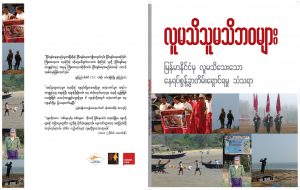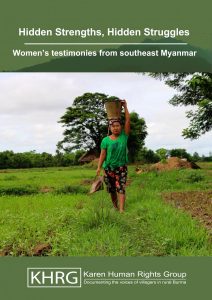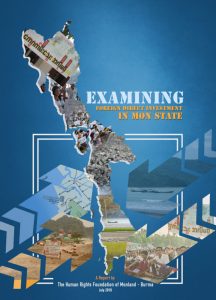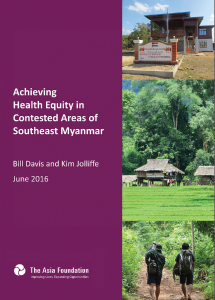Women (156 found)
Fleeing Sexual Violence from Yebyu Township to the Thailand-Burma Border: Mon IDP Report Case Study #1
The following case study is from the joint report “Invisible Lives: The Untold Story of Displacement Cycle in Burma” by Human Rights Foundation of Monland (HURFOM), Burma Link, and Burma Partnership, which was launched in a press conference in Rangoon on August 12th and in Moulmein on August 15th […]
• • •“A Gentleman’s Agreement”
Women make up just over half of the population in Burma, but have been noticeably absent from nearly four years of peace negotiations to end armed conflict in the country […]
• • •United States Commission on International Religious Freedom – Burma: 2016 Annual Report
In 2015, peaceful elections ended more than 50 years of military-controlled government in Burma, yet the new government faces myriad human rights chal-lenges. Throughout the year, Burma’s government and non-state actors continued to violate religious freedom; these violations became a defining element of the campaign season […]
• • •လူူမသိသူမသိဘ၀မ်ား – ျမန္မာႏိုင္ငံမွ လူမသိေသးေသာေနရပ္စြန္႔ခြာတိမ္းေရွာင္ရမႈ သံသရာ
 လတ္တေလာကာလ ျမန္မာ့အေရးႏွင့္ပတ္သက္လွ်င္ ဒီမိုကေရစီျပဳျပင္ ေျပာင္းလဲေရး၊ ၂၀၁၅ ေရြးေကာက္ပြဲႏွင့္ အမ်ိဳးသားဒီမုိကေရစီအဖဲြ႔ခ်ဳပ္ (NLD) ဦးေဆာင္ေသာအစိုးရ၏ အနာဂတ္တို႔ အေပၚသာ အာရံုစိုက္မႈမ်ားေနၿပီး အလြန္နက္နဲေသာ လူသားခ်င္းစာနာမႈ အက်ပ္အတည္း ႏွင့္ ျမန္မာႏုိင္ငံအေရွ႕ေတာင္ပိုင္းမွ တိုင္းရင္းသားလူနည္းစု အသိုင္းအဝိုင္းတို႔၏ ဆက္လက္စိုးရိမ္ပူပန္ေနရမႈမ်ားအား အမ်ားအားျဖင့္ လ်စ္လ်ဴ႐ႈထားၾကသည္ […]
လတ္တေလာကာလ ျမန္မာ့အေရးႏွင့္ပတ္သက္လွ်င္ ဒီမိုကေရစီျပဳျပင္ ေျပာင္းလဲေရး၊ ၂၀၁၅ ေရြးေကာက္ပြဲႏွင့္ အမ်ိဳးသားဒီမုိကေရစီအဖဲြ႔ခ်ဳပ္ (NLD) ဦးေဆာင္ေသာအစိုးရ၏ အနာဂတ္တို႔ အေပၚသာ အာရံုစိုက္မႈမ်ားေနၿပီး အလြန္နက္နဲေသာ လူသားခ်င္းစာနာမႈ အက်ပ္အတည္း ႏွင့္ ျမန္မာႏုိင္ငံအေရွ႕ေတာင္ပိုင္းမွ တိုင္းရင္းသားလူနည္းစု အသိုင္းအဝိုင္းတို႔၏ ဆက္လက္စိုးရိမ္ပူပန္ေနရမႈမ်ားအား အမ်ားအားျဖင့္ လ်စ္လ်ဴ႐ႈထားၾကသည္ […]
International Religious Freedom Report for 2015
The constitution guarantees every citizen “the right to freely profess and practice religion subject to public order, morality or health and to the other provisions of this Constitution.” The government adopted a package of four laws that many local and international nongovernmental organizations (NGOs) said were an infringement on religious freedom and other basic rights […]
• • •Women’s Inclusion in Myanmar’s Nationwide Ceasefire Agreement
Ceasefire agreements play a crucial role in ending armed conflict. They are often the primary tool to reduce or stop violence and create space for political negotiations. Due to their technical nature, ceasefire talks have been historically exclusive processes between governments and armed groups. While a growing body of research has addressed ceasefire design and implementation, there is still a dearth of knowledge about the inclusion of women in ceasefire negotiations […]
• • •Hidden Strengths, Hidden Struggles: Women’s testimonies from southeast Myanmar
 This report presents women’s testimonies in respect of various issues during the reporting period of January 2012 to March 2016. These issues include the dangers posed to women by the presence of armed actors in communities; the effects of land confiscation and development projects on women’s livelihoods; women’s access to healthcare and education; the continued occurrence of gender-based violence; and the harms caused by landmines; forced labour; arbitrary taxation and extortion […]
This report presents women’s testimonies in respect of various issues during the reporting period of January 2012 to March 2016. These issues include the dangers posed to women by the presence of armed actors in communities; the effects of land confiscation and development projects on women’s livelihoods; women’s access to healthcare and education; the continued occurrence of gender-based violence; and the harms caused by landmines; forced labour; arbitrary taxation and extortion […]
Examining Foreign Direct Investment in Mon State, Burma
 Over the years, the Human Rights Foundation of Monland (HURFOM) has produced a number of accounts highlighting the hardship faced by Mon people who have become victims to land confiscation […]
Over the years, the Human Rights Foundation of Monland (HURFOM) has produced a number of accounts highlighting the hardship faced by Mon people who have become victims to land confiscation […]
Achieving Health Equity in Contested Areas of Southeast Myanmar
 Throughout decades of ethnic armed conflict, the governance environment in many of Myanmar’s non- Burman areas has become deeply fractured, as ethnic armed organizations (EAOs) have established parallel governance systems, including healthcare departments. This report gives an overview of the parallel Ministry of Health (MoH) and EAO-linked health systems that exist in southeast Myanmar, and looks at how coordination and cooperation have increased since ceasefires were signed in 2011 and 2012 […]
Throughout decades of ethnic armed conflict, the governance environment in many of Myanmar’s non- Burman areas has become deeply fractured, as ethnic armed organizations (EAOs) have established parallel governance systems, including healthcare departments. This report gives an overview of the parallel Ministry of Health (MoH) and EAO-linked health systems that exist in southeast Myanmar, and looks at how coordination and cooperation have increased since ceasefires were signed in 2011 and 2012 […]
Myanmar CSO Shadow Report on Thematic Issues: Violence against Women
This CEDAW Shadow Report is written by CEDAW Action Myanmar (CAM). This working group is established in 2012 and consists of 15 local organizations. The report consists of perceptions of 309 (with 226 women and 83 men) respondents who participated in a survey; along with news from print and social media […]
• • •
 All posts
All posts